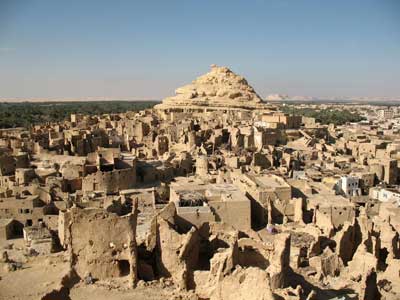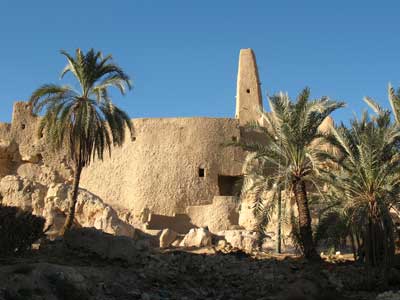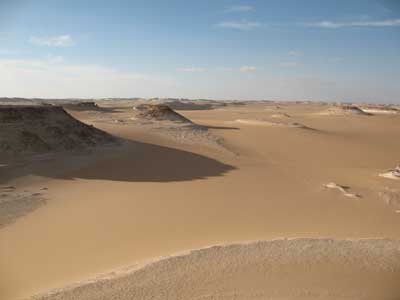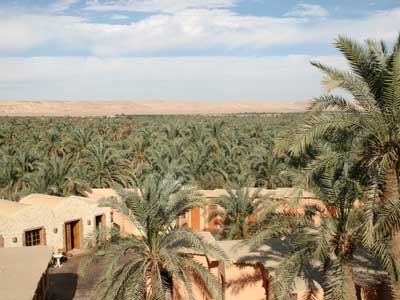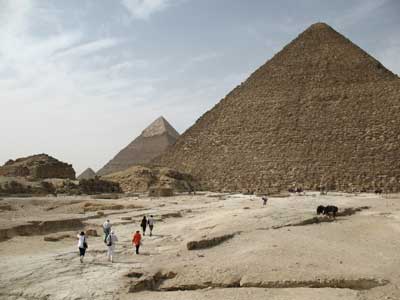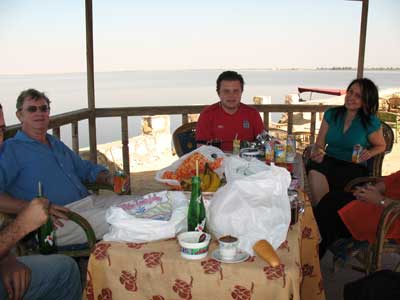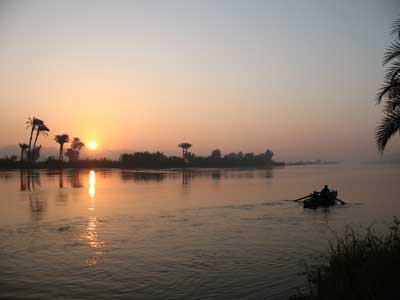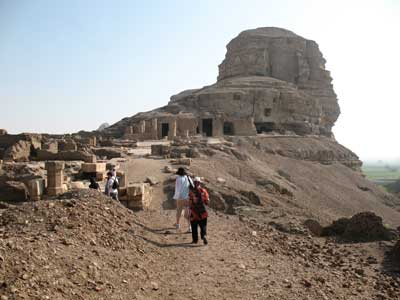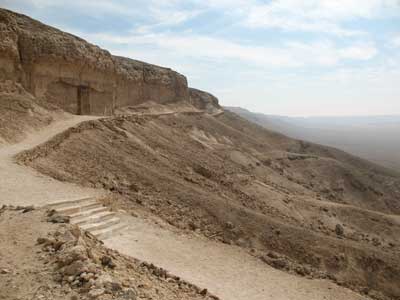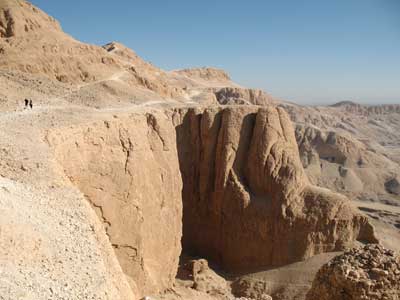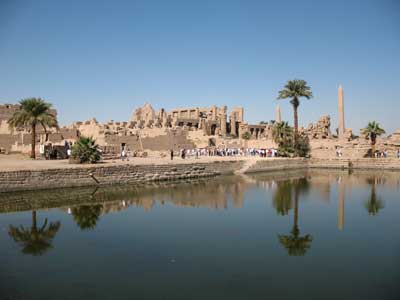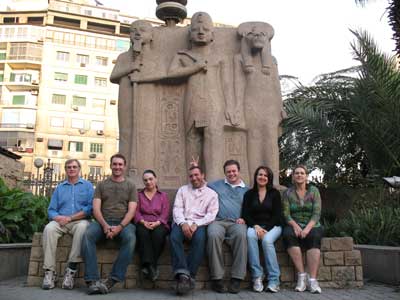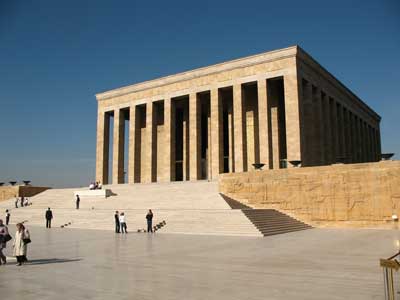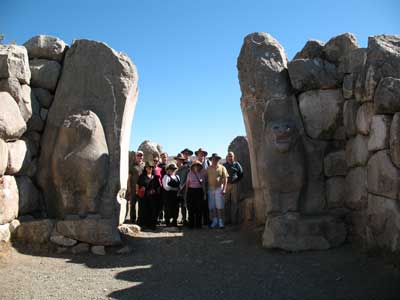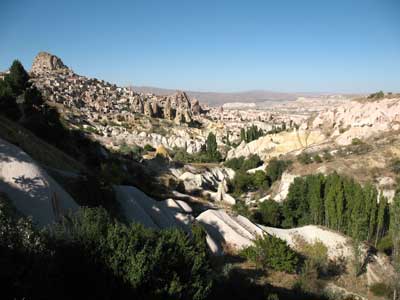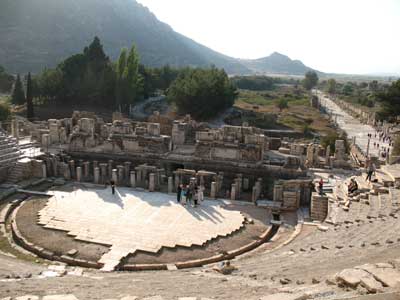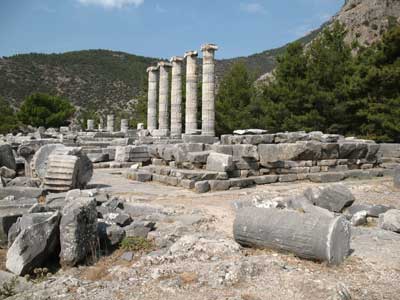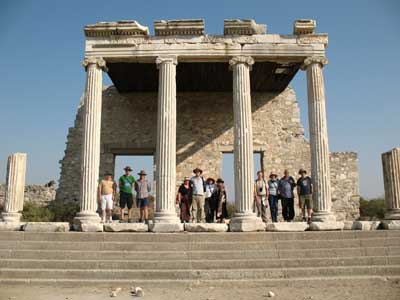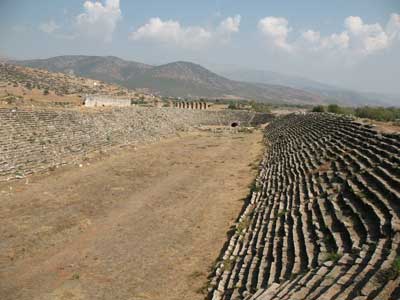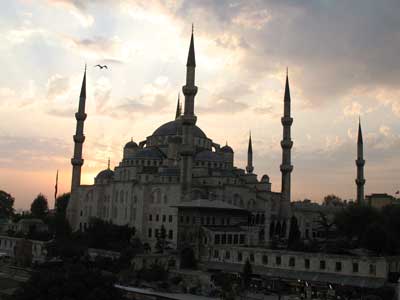



|
|
|
|
|
TOUR NEWS Welcome to the Tour News of 'B.C. Archaeology Tours' where we take the opportunity to recap on our recent tour programs. We've had an exciting six months at the company with 2 tours run from July 2007 till January 2008. This included a tour to Turkey in September 2007 and a tour to Egypt concentrating on Amarna period sites (18th Dynasty). In December, I went to Siwa and Bahariya Oases in the Western Desert of Egypt to make preparations for the upcoming tour of the Oases in February 2009. MICHAEL'S TRIP TO SIWA OASIS AND BAHARIYA OASIS
In December I had an opportunity to travel out to some of the Oases in preparation for the upcoming Western Desert Oasis Tour which we are running in February and March 2009. The aim was to have a look at the hotel options and consider day excursions for the new trip. I headed from Cairo to Siwa Oasis by bus - the trip takes you NW out of Cairo and avoids Alexandria by using a new road which connects to the Mediterranean shore near El Alamein. The trip across this stretch of desert takes you through flat, open country before you reach the sea. We proceeded to Mersa Matruh, the main settlement along this stretch of coast and then headed inland to Siwa Oasis, passing quite close to the Libyan border to the west. This flat open desert was once crossed by Alexander the Great on his way to visit the oracle of Zeus Ammon at Siwa. The appearance of the oasis and the descent into the depression is a wonderful relief! I stayed in the Siwa Paradise Hotel, which is a very pleasant complex about 200 m from the centre of town. It was very pleasant to walk into town and watch a spectacular sunset from a restaurant in the old city. The following morning I returned to the Old City (the Shali) to explore its fascinating winding streets. One the medieval town, few people live in the crumbling ruins, but the place still resonates with a spirit of the past.
In Siwa I also visited the dramatically named Gebel Mawta 'Hill of the Dead' the location for the main cemetery of the Oasis. The hill, which rises out of the palm gardens, contains stunning painted tombs of the Late Period and Ptolemaic Period, and was used by traders and noblemen who lived in this remote location. A highlight of the Oasis trip was, without question, the day excursion into the Great Sand Sea by 4-wheel drive. We started by exploring the western edge of the Oasis where we found numerous fossil beds and whole areas of coral and deep deposits of shells. We also saw rock art from more recent human habitation, and most fascinating was a visit to a meteor impact site with fragments of extra-terrestrial debris scattered all around! We headed into the deep desert, leaving all sign of growing things behind. The dunes are absolutely stunning (some up to 30 m high), and we crossed through a towering landscape of wind fashioned hills. In front of us the great expanse of the open desert, coupled with the absolute silence, was remarkable. The afternoon ended with a relaxing soak in a hot thermal spa in the middle of the desert at Bir Wahed.
I left Siwa Oasis and then headed across the open desert in a 4-wheel drive. On the way to Bahariya Oasis we stopped at Nuwamisa Oasis, a real 'Hollywood' style Oasis pool in the desert surrounded by a few palm trees. The landscape is stark and beautiful here. Bahariya Oasis is a much larger depression than Siwa with a huge expanse of palm gardens. Being closer to the Nile, SW of Cairo, it has been more closely linked with the civilisation of pharaonic Egypt. I stayed in a pleasant hotel near the edge of the gardens. In Bahariya I explored the fascinating antiquities of the region. In the morning I wandered through the palm gardens and explored the old town of Bawiti with its winding alleys - people still live a simple life here! I also visited the local museum with its collection of the recently discovered 'Golden Mummies' from the Ptolemaic Period. I also saw the interesting remains of the Ain Muftella temple and the ruins of the temple of the deified King Alexander the Great. A highlight of Bahariya is to explore the fascinating painted tombs of the local officials. These are just a few of the splendid experiences on the Western Desert tour which will also include a visit to Farafra, Dakhleh and Kharga Oases. The program will conclude with an optional extension to the program - a 4-wheel drive trip into the deep desert to visit the Gilf Kebir and the Gebel Uweinat near the Libyan border. The region is famous for its stunning desert landscapes and fascinating Neolithic rock art. AMARNA EGYPT TOUR - NOVEMBER-DECEMBER 2007
The B.C. Archaeology Tour of Amarna Egypt in November-December 2007 was a great success with everyone enjoying our exploration of the remarkable sites connected with the Amarna Period. We had a relatively small group which consisted of only 7: Allan Stuckey, Anne Heart, Teresa Romanovsky, Sebastian Cobb and Brenda Wass. The group leader was Dr Michael Birrell and the Egyptian guide was Mohamed Aziz (otherwise known as Aziz). We arrived into Cairo International Airport in the late evening and checked into the Victoria Hotel located in the downtown part of Cairo. The following morning was spent at Giza where we walked around the outside of the Great Pyramid of Khufu and saw the superb cedar boat of the king. We then visited the pyramid of Khafre and after entering the pyramid, wandered around the impressive Mortuary Temple near the sphinx. In the afternoon we headed to the Khan el-Khalili markets where we spent a few hours exploring the numerous hidden alleys with their many shops. We started next morning at Saqqara where we went to see the Imhotep Museum, a new collection of artifacts from the site which have not been seen by the public before. Amongst the many treasures are the painted wooden ka-statues of the local tomb owners. We then saw the Third Dynasty Step Pyramid of Zoser, one of the great masterpieces of Egyptian architecture. We also visited the tombs of Nianch-khnum and Khnum-hotep, and the impressive mastabas of Mereruka and Kagemni. We also descended into the pyramid of King Tety to discover the Pyramid Texts of the King. We next spent a day at the dramatic desert sites of Meidum and Dahshur - both Old Kingdom sites which preserve a stark and isolated feeling largely because they are off the main tourist track and are therefore blissfully clear of crowds. Amongst the great pleasures of visiting these sites is the experience of descending into the burial chambers of the main pyramids and crawling through the robber's tunnel into Mastaba 17 at Meideum. The following morning we drove across the western desert from Cairo to the edge of the Fayyum Oasis. Here we saw the extensive ruins of the Roman Period town of Karanis with two stone temples, ruined houses and baths. Lunch was spent in a restaurant located at the edge of the Fayyum Lake. In the afternoon we stopped at the pyramid of Senwosret II at Lahun and then heading south via the desert road to Minya, our base for the next five days.
We had a morning of leisure in Minya, enjoying the most spectacular sun rise. Our hotel, the Aton Hotel, was located immediately on the edge of the Nile and it was always pleasant to spend time by the river watching the fishermen and birdlife. In the afternoon we travelled north by bus to see the ruins of the ancient city of Akhoris, now called Tehna el-Gebel. Here we saw the dramatic temple built by Nero, a rock-cut shrine dug into the face of a spectacular outcrop of rock. We also saw the ruins of the Roman city, and experienced a superb view over the agricultural zone. The following day took us south of Minya to see a number of sites on the eastern bank. The first stop was Beni Hasan where we saw the beautiful painted tombs of the 11th and 12th Dynasty. The view across the Nile is always breathtaking from the terrace in front of the monuments. We had a picnic lunch in the local caf� at Beni Hasan before heading to see the desert temple of Queen Hatshepsut of the 18th Dynasty. We next spent two days exploring the ancient city of Akhetaten, also called Amarna. We toured the superb painted North Tombs with their stunning view across the desert plain. We also saw one of the monumental Boundary Stelae, carved by Akhenaten to define the limits of his new city, and explored the ruins of the North and Riverside Palaces and the houses in the North City. One of the highlights of the visit is to experience the crossing of the Nile River on the local ferry with its colourful scene of village life including camels loaded with goods. On our second day at Amarna we descended into the Royal Tomb, built to house the remains of King Akhenaten and his immediate family. The tomb is carved in an isolated desert valley east of the city. We then explored the ruins of the ancient city including the temples to the Aten and the Royal Palace. The afternoon was spent in the South Tombs where we looked at the Hymn to the Aten in the tomb of Ay. The next morning we travelled south of Minya to the town of Malawi where we stopped to see the local archaeological Museum. We then went to nearby Tuna el-Gebel where we exlored the painted Ptolemaic tombs, including the famous Greek tomb of Petosiris, as well as the atmospheric underground catacombs housing the mummified remains of the sacred ibises and baboons of Thoth. We had a pleasant picnic lunch at the site. In the afternoon we saw the ruins of the temple of Thoth at Ashmunein and the picturesque Christian cathedral of the 5th Century.
The following day we caught the First Class train to Luxor. The train left Minya mid-morning and arrived into Luxor in the late afternoon. The trip enabled us to sit back and watch the colour and bustle of the local landscape as we headed south. Time was spent reading, listening to music and chatting. The following morning we visited Luxor Temple, located in the heart of the modern city. We explored this beautiful monument thoroughly, concentrating on the remains of the Amarna Period in particular. These included the impressive Opet Festival scenes of Tutankhamun and the religious scenes of Amenhotep III. We had lunch in a caf� and then took a felucca sail boat ride on the Nile. A spectacular sunset was our reward! In the evening we saw the impressive Luxor Museum with its famous talatat relief scenes from Akhenaten's demolished Aten temple at Karnak. Next day we walked the desert path across the Theban Hills from Deir el-Medina to Deir el-Bahri, stopping along the way to look down into the Valley of the Kings. Our walk took us along the edge of the great precipice that rises behind the temple of Queen Hatshepsut and certain members of the group were keen to keep as far away from the edge as possible! The view however was worth the effort, especially looking over the green fields towards the Nile. We descended from the Theban Hills to spend the rest of the morning at the famous mortuary temple of Queen Hatshepsut of the 18th Dynasty. We had lunch on the West Bank before travelling by bus to the Valley of the Kings. Here we saw a number of royal tombs including the tomb of Tutankhamun in the main Valley and the tomb of King Ay in the West Valley.
We then spent a day exploring the extensive ruins of Karnak Temple with a special emphasis on the Amarna Period. The new paved forecourt in front of the temple is impressive but somehow bleak and impersonal - it's a shame that the local restaurants were demolished as well. We saw the Hypostyle Hall, the Third Pylon, and the 18th Dynasty Festival Hall of Tuthmosis III. The following day was spent on the West Bank of the Nile at Luxor. We started at the Colossi of Memnon, the two monumental seated statues of King Amenhotep III. From here we went to Deir el-Medina where we saw the remains of the Workers Village and explored two wonderful painted tombs. Lunch was in a nearby caf� - in the afternoon we toured three painted tombs of the 18th Dynasty. The following day was set aside for rest and relaxation. The author enjoyed a felucca ride in the afternoon. The evening was spent at the hotel where we enjoyed a wonderful buffet dinner and entertainment by village musicians and dancers. We saw a 'sufi' whirling dancer, but the highlight of the evening was definitely Teresa's belly dancing performance which far surpassed the local talent - well done Teresa!
We flew to Cairo next morning. We explored part of the Old City of Cairo and saw awe inspiring buildings of the Islamic Period - including the Mohamed Ali mosque and the monumental Mosque of Sultan Hassan. The day ended with shopping in the Khan el-Khalili markets. The next day was spent in the Cairo Museum with a guided tour focussing on the 18th Dynasty remains. We saw the statues and reliefs of the Amarna period, the treasures of Tutankhamun and the burial equipment of Yuya and Tjuya, parents of Queen Tiye. There was also free time for exploring other parts of the museum's remarkable collection. A wonderful tour and great fun! TURKEY TOUR - SEPTEMBER-OCTOBER 2007
The B.C. Archaeology Tour of Turkey for 2007 took place in September and October and was a great success with everyone enjoying the archaeological sites of this wonderful country. There were 12 of us including: Ian Casey, Daniel Glancy, Kevin Hayes, Graham Littlejohn, Jacinta Prentice, Alex Radford, Caroline and Bryan Riddell, Philippa Shaw and Toni Messiter. The tour leader was Dr Michael Birrell and our Turkish guide was the wonderful Deniz who really gave us her insight into life in Turkey. The tour began with the group arriving in Istanbul. About half the participants had come early to spend a few days in this wonderful city before the start of the program including: Michael, Ian, Daniel, Graham, Caroline and Bryan - this gave us the chance to explore some of the other places in the area. We explored numerous mosques and churches and some of us took the public ferry up the Bosphorus to the entrance to the Black Sea. This is such a pleasant experience that we will be adding it to the program in future. The group was united at Istanbul airport and we drove to Ankara, passing though some beautiful, scenic country on the way as we skirted the edge of the Sea of Marmara. We had some lunch en route and when we arrived we headed to the Mausoleum of Ataturk in the centre of Ankara. This dramatically located building, inspired by classical and modern fascist architecture, contains an excellent war memorial with an emphasis on the Gallipoli campaign and WWI.
The following day we explored the excellent Museum of Anatolian Civilisations with its impressive collection of artefacts from the Paleolithic Era down to the Roman period. The collection is housed in a beautiful Selcuk han (caravanserai) and is excellently labelled. Of particular interest are the neo-Hittite reliefs from Carcamesh and the Assyrian letters from Kanesh. We went for a walk in the medieval fort of Ankara which provides a panoramic view over the city for our lunch. We also had a look at the famous Res Gestae text of Augustus. In the afternoon we drove NE of Ankara to our hotel near Bogazkale. We all kept our eyes peeled for the Halys River (today called the Kizilirmak) but somehow we managed to pass it by without realizing! The following day was dedicated to the ancient Hittites as we make a short trip by bus to Hattusas, the capital of these ancient peoples. In the morning we toured the city ruins including the royal citadel, the Great Temple and the impressive city gates. We had a very pleasant lunch in a nearby caf� and then went to see the rock-cut shrine of Yazilikaya which preserves remarkable representations of the Hittite pantheon. The following morning we saw the antiquities of Alaca Huyuk, an ancient fortified Hittite site with tombs. We then travelled south by bus to the region of Cappadocia, famous for its remarkable landscape of natural 'fairy chimneys' made from volcanic pumice (we finally encountered the Halys River in its upper reaches!). We checked into our comfortable hotel in Urgup. In the afternoon we visited the old city of Uchisar and climb to the top of the pumice castle for a superb view over the whole of Cappadocia. In the evening we saw a wonderful display of sufi dancing at a magnificently restored Selcuk han.
The following day we travelled by bus to the village of Goreme where we saw the famous painted churches. Carved from the volcanic pumice, these mediaeval churches are richly decorated with Biblical scenes. We also saw the ruins of the ancient settlement of Zelve, home to a monastic community in the Middle Ages. The inhabitants cut their houses and the monasteries from the local volcanic pumice and protected their dwellings by movable boulders (very Indiana Jones!). We enjoyed a delightful picnic amongst the ruins. Next morning was set aside for rest and relaxation. Many members of the group opted for an early morning balloon ride over this fantastic landscape. We had a perfect clear morning with views to the Erciyes volcano in the distance. The rest of the day members of the group went walking, or shopping. In the evening we flew to Izmir and then travelled the short distance by bus to Selcuk, our base for the next 6 days as we explored the archaeological sites of the local area. Our first day in the Selcuk area was devoted to exploring the ruins of Ephesus. In the morning we stopped to look at the remains of the Artemis Temple, one of the ancient Seven Wonders of the World. At Ephesus we wandered round the city, admiring the small theatre, the marble monuments of Curetes Street, the temple of Hadrian, the remarkable library of Celsus (for which Ephesus is most famous) and the awe inspiring Hellenistic and Roman theatre. As a special part of our program, we saw the fascinating ruins of the Roman private houses which preserve beautiful frescos and mosaics. In the morning we travelled south to Priene, an ancient city located on a dramatic hill overlooking the Meander River. This superb site includes a picturesque agora (town square), town council hall, theatre, and magnificent Temple of Athena. It was a perfect sunny day and we enjoyed walking through the forest of pines which grows through the ruins. We had lunch in the local town and then returned to Selcuk. In the afternoon we had a look at some Turkish carpets and visited the Archaeological Museum, home to a superb collection of Classical and Roman sculpture from Ephesus. A highlight is the remarkable statue of Artemis draped in bulls testicles!
The following day we explored the ruins of the ancient city of Miletus and the Temple of Apollo at Didyma. The morning was spent at Didyma - here we see the awe inspiring ruins of the Temple, one of the largest in the Classical world and once home to a famous oracle. We had a pleasant picnic lunch at Miletus before exploring the picturesque ruins. Highlights included the monumental Hellenistic and Roman theatre, the agora and the well preserved Baths of Faustina. We next visited Aphrodisias, cult centre of the famous goddess of love. We wandered through this gorgeous place, set in a lush green area of the Meander River. Aphrodisias is renowned for its remarkably well preserved Roman stadium, theatre and agora (marketplace). A highlight of the visit was the museum, with its impressive collection of Roman sculpture from the site. The following day was a free day to relax, read a book, or go shopping in the markets of Selcuk. Some members of the group went to see nearby archaeological sites (for just one extra dose of antiquity!). In the afternoon we visited the village of Sirince, a pleasant village in the foothills renown for its cottage industry. We next headed north to Bergama after stopping to have a look at some Turkish leather - Bryan looked particularly fetching in a leather motorcycle cap! We spent the afternoon in the fascinating Archaeological Museum of Bergama which preserves magnificent sculpture and other artefacts from the local excavations as well as models of the chief monuments. The following day we visited the superb ruins of the ancient city of Pergamum, a Hellenistic city perched on the summit of a precipitous mountain. Highlights of the day included the acropolis area with its royal palace, theatre, library and temple dedicated to the Roman Emperor Trajan. We were also lucky to see the display of the Roman house with mosaics which is not often open. In the afternoon we saw the Temple of Serapis (the 'Red Basilica') and the enclosure of Asclepeios, god of Medicine. Here we were revived by a drink from the pleasant fresh water spring. At the end of the day we explored one of the huge tumulus tombs, even convincing our Turkish guide Deniz to follow us into the gloom! We travelled north by bus from Bergama to the ruins of Troy. On the way we passed through some beautiful mountainous scenery. Opposite the island of Lesbos, in a cool olive grove, we stopped to hear Jacinta read some of the poems of Sapho - magic! At Troy we explored the remarkable ruins of this picturesque archaeological site, famously excavated by the German entrepreneur Heinrich Schliemann in the late 19th Century. We stopped for a while to reflect on the words of Homer as we imagined the sack of the city. In the afternoon, we had a short bus ride to �anakkale where we checked into our hotel. In the morning we crossed the Dardanelles to the Gallipoli Peninsula and explored the WWI battle fields of Gallipoli including Anzac Cove, Lone Pine and the Nek. No visitor to the can fail to be moved by the story of heroism and we were so lucky to have Jacinta read from family letters enabling us to appreciate the incredible hardships of the fighting. In the afternoon we headed north by bus to Istanbul where we went to the Grand Bazaar to explore the warren of shops.
|
